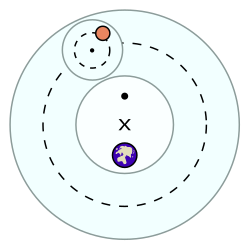User:SeanMcMahon/sandbox

Equant (or punctum aequans) is a mathematical concept developed by Claudius Ptolemy in the 2nd century AD to account for the observed motion of heavenly bodies. The equant is used to explain the observed speed change in planetary orbit during different stages of the zodiac.
Equation
[edit]The equant point, indicated in the diagram by the large • , is placed so that it is directly opposite the Earth from the center of the deferent, indicated by the X. A planet or the center of an epicycle (a smaller circle carrying the planet) was conceived to move with a uniform speed with respect to the equant. In other words, to a hypothetical observer placed at the equant point, the center of the epicycle would appear to move at a steady speed. However, the planet/center of epicycle will not move uniformly on its deferent. The angle α between the axis on which the equant and the Earth lie is a function of time t:
where Ω is the constant angular speed seen from the equant which is situated at a distance E when the radius of the deferent is R.[1]
Discovery and Use
[edit]Ptolemy introduces the equant in Almagest. The evidence for the equant relies mostly based on observations made by himself and an associated named Theon that is mentioned. He asserts that the epicycle's center is carried on a circle, the deferent, whose center is different from the center of uniform motion. Ptolemy never mentions how he arrived at his discovery, however the idea of the equant point was introduced during Ptolemy's explanation of longitudes and equants are later found through direct calculations. These calculations show that the center of the deferent lies halfway between the Earth and the equant point.[2]
The reason Greek astronomers adopted Ptolemy's model of celestial movement was due to apparent inequalities observed in planetary motion, specifically the movement of Mars, which showed apparent retrograde motion. Mars, Jupiter, and Saturn reach the middle of their retrograde arcs when they are in opposition to the sun, while Mercury and Venus reach the middle of their retrograde arcs when they are in conjunction with the sun. Using the equant, Ptolemy can then account for the lengths of each planets retrograde arcs.
The equant accounted for a third of the basic constructions of the Ptolemaic model of planetary motion. The first part of the model is the eccentric. The eccentric places Earth slightly off-center of the planet's path. This can be seen in the image above, shown by the center, X, and the Earth underneath it. The second part of the model is the epicycle. This is illustrated in the image by the orange planet orbiting the small circle while moving along its larger orbit. When the speed and direction of the planets rotation were applied annual retrograde motion could be accounted for. These two constructs alone did not form a complete model of planetary motion, so a third part was added to the model, the equant. This resulted in the geometric center, X, being replaced by the equant, • , as the center of motion. This model broke down the planetary motions while still maintaining perfect circular motions.
Ptolemy's model of astronomy was used as a technical method that could answer questions regarding astrology and predicting planets positions.
Opposition
[edit]This concept solved the problem of accounting for the anomalistic motion of the planets but was believed by some to compromise the goals of the ancient astronomer, namely uniform circular motion. Noted critics of the equant include the Persian astronomer Nasir al-Din Tusi who developed the Tusi-couple as an alternative explanation,[3] and Nicolaus Copernicus. Dislike of the equant was a major motivation for Copernicus to construct his heliocentric system.[4][5] The introduction of the equant point meant that Ptolemy was breaking a long standing rule put in place by Aristotle, planetary motions no longer centered around the Earth, the center of the cosmos.[6] This violation of perfect circular motion around the Earth bothered many thinkers, especially Copernicus who mentions the equant as a monstrous construction in De Revolutionibus.
References
[edit]- ^ Eccentrics, deferents, epicycles and equants (Mathpages)
- ^ Evans, James (1984). "On the function and the probable origin of Ptolemy's equant". American Journal of Physics (52): 1080.
- ^ Craig G. Fraser, 'The cosmos: a historical perspective', Greenwood Publishing Group, 2006 p.39
- ^ Kuhn, Thomas (1957 (copyright renewed 1985)). The Copernican Revolution. Harvard University Press. pp. 70–71. ISBN 0-674-17103-9.
{{cite book}}: Check date values in:|year=(help)CS1 maint: year (link) - ^ Koestler A. (1959), The Sleepwalkers, Harmondsworth: Penguin Books, p. 322; see also p. 206 and refs therein. [1]
- ^ Van Helden. "Ptolemaic System". Retrieved 20 March 2014.
External links
[edit]- Ptolemaic System – at Rice University's Galileo Project
- Java simulation of the Ptolemaic System – at Paul Stoddard's Animated Virtual Planetarium, Northern Illinois University
See also
[edit]- Equidimensional: This is a synonym for equant when it is used as an adjective.
Category:Ancient Greek astronomy Category:Trigonometry Category:History of astronomy Category:Ancient astronomy


